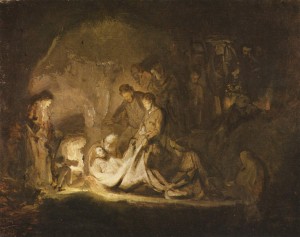
Earlier this month, we talked about the perception that US science funding is harder to secure than it used to be. There are several tensions at play — evolutionary increments vs revolutionary leaps, the boldness of youth vs the established old guard — or at least that is how the discussion was framed. I wonder though if there is another subtext: what is science?
De facto, science is whatever we spend our science dollars on. Therefore, we want to make sure that funding covers the complete range of scientific activities. Only, there still seems to be a lot of discussion about how to define science. There is a desire to differentiate science from other academic pursuits like theology or philosophy, and to distinguish science from magical thinking. Just in the past week, I’ve come across two very different attempts to draw the boundaries of science.
First is this essay by Pascal-Emmanuel Gobry that has been circulating on my news feeds. He seems concerned that we have incorrectly extrapolated from Clarke’s “any sufficiently advanced technology is indistinguishable from magic” to “science can achieve any sort of magic we want.” As a corrective, he defines science as “the process through which we derive reliable predictive rules through controlled experimentation.” Anything that hasn’t been repeatedly studied in a controlled environment doesn’t qualify science, no matter how much math, data or methodological rigor is involved.
I suspect Gobry’s perspective has attracted attention partly because he explicitly separates science and religion. He seems to be in the nonoverlapping magisteria school, which doesn’t quite resonate with me. Still, I think he is onto something when he suggests that our expectations are collectively off-kilter in certain domains, leading to a misunderstanding when certain predictions don’t bear fruit. I’m not sure if that’s a misapplication of the label “science” or an insistence on reducing conditional, probabilistic predictions to binary absolutes, but it is a problem that is eroding the public confidence in experts, if not science itself.
Yet the definition is clearly too narrow. There is an observational, exploratory phase that is critical to science which is not represented. Are astronomers or field biologists who make inferences from data gathered in the wild not scientists? Does the phrase “reliable predictions” mean that Newtonian mechanics were no longer science once they failed to predict Mercury’s orbit? And how much control is enough? Are we back to the days when the only real science was physics and the rest was stamp collecting? In attempting to dispel myths, Gobry still seems to be perpetuating some; it reminds me of the old joke about organized crime — “Don’t kid yourself, it’s not that organized.”
Meanwhile, I have begun reading Howard Bloom’s “The God Problem” and Bloom has some very grandiose ideas about what science is. While I am still early in the book, it is clear that Bloom sees science as the new and improved 2.0 version of what religion was invented to accomplish. In his view, our attempts to answer questions like “why is there something rather than nothing” first yielded variations on “Because God.” He seems willing to concede that as a reasonable answer for its time, but now that we have science we can get rid of our earlier, flawed models. Science is a competing narrative to religion about why the world exists and what purpose it has; it subsumes philosophy, theology and other epistemologic pursuits.
His version of science has two rules. First, the truth at any price, including the price of your life. Second, look at things right under your nose as if you’ve never seen them before, and then proceed from there. I have to admit, I found these rules captivating; I had never heard science described quite so grandiloquently. Even more intriguing are the implications.
Bloom concludes that religions are a primitive and manufactured attempt to explain the world because he rejects the idea of God. He frames this rejection around the problem of evil; since evil exists, either God isn’t good or he isn’t omnipotent (and, by implication, not God). Yet here Bloom seems to skip his second rule about questioning assumptions; he has assumed that God will be ultimately comprehensible to a (admittedly precocious) ten year old, given the biography Bloom offers. Since he often describes God as bearded and bathrobed, essentially the God of Far Side cartoons, it is perhaps not surprising that he expects God to be fully understood. His God is basically a schlub just like us, only with more power, a sort of wizard more than anything else.

But even more fascinating to me is rule number 1. The truth at any price, including the price of your life. I feel like I’ve heard that before, only not in any science book. Bloom even goes so far as to say that, in the pursuit of truth, we should be willing to lay down our life to stop the evil in the world that convinced him there is no God. What a fantastic idea! Dying to end all the evil in the world. It’s a shame God didn’t think of it first.
As you might imagine, I think Bloom is a bit far-reaching with his definition of science. He seems to see all Truth as science Truth, just as Gobry warned. But Gobry goes too far in his own way as well, drawing so tight a boundary around science that all the life seems to be squeezed out of it.
One needn’t squint too hard to see how these competing ideas of science influence funding. An emphasis on reliable predictions and controlled experiments leads to risk-averse investment in the kinds of research that are already supported by extensive prior work. A grand vision for science that pushes limits and breaks down barriers will more likely inspire investments with tremendous upside but long odds — which may or may not be the best use of limited public funds. I wish I had a better definition of science that would help clarify these funding questions, because until we find one I suspect we will continue to angst over what sort of science to buy.
Andy has worn many hats in his life. He knows this is a dreadfully clichéd notion, but since it is also literally true he uses it anyway. Among his current metaphorical hats: husband of one wife, father of two teenagers, reader of science fiction and science fact, enthusiast of contemporary symphonic music, and chief science officer. Previous metaphorical hats include: comp bio postdoc, molecular biology grad student, InterVarsity chapter president (that one came with a literal hat), music store clerk, house painter, and mosquito trapper. Among his more unique literal hats: British bobby, captain’s hats (of varying levels of authenticity) of several specific vessels, a deerstalker from 221B Baker St, and a railroad engineer’s cap. His monthly Science in Review is drawn from his weekly Science Corner posts — Wednesdays, 8am (Eastern) on the Emerging Scholars Network Blog. His book Faith across the Multiverse is available from Hendrickson.

Leave a Reply